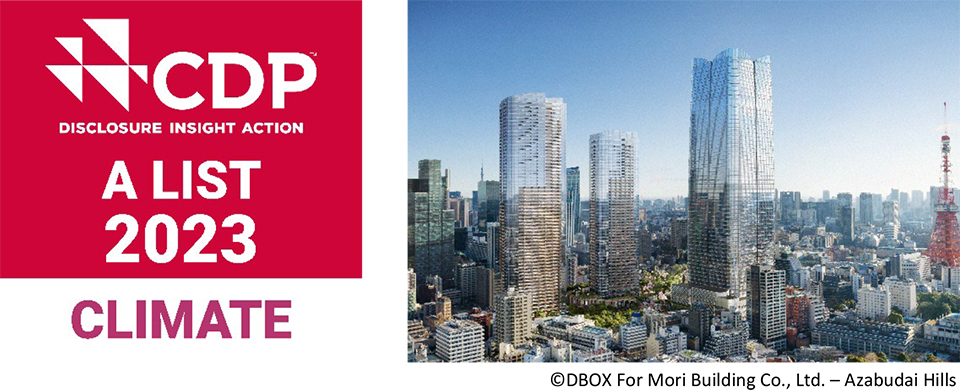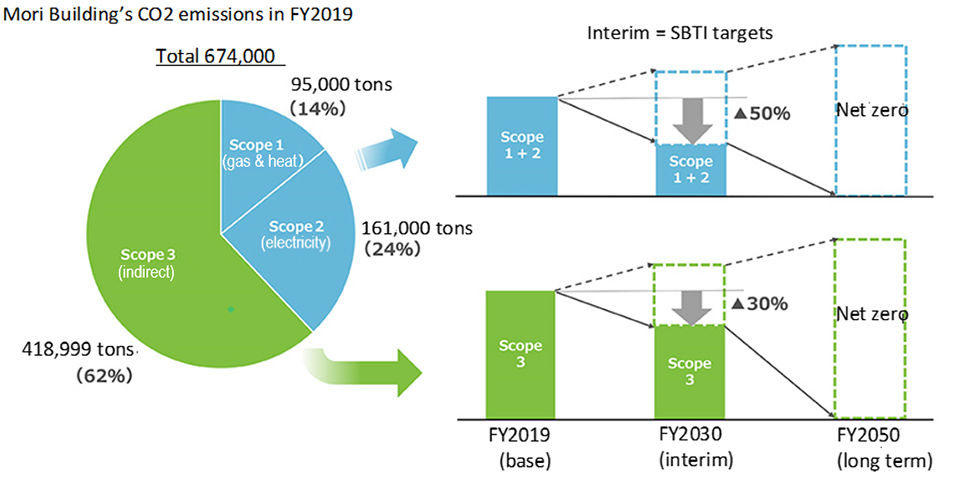Tokyo, February 20, 2024 -- Mori Building Co., Ltd., Japan's leading urban landscape developer, announced today that it has been named to the Climate Change A List by the CDP, a London-based international non-profit organization that assesses and certifies the environmental policies and initiatives of companies and other organizations. For Mori Building, the top rating is a coveted validation of the company's efforts to demonstrate leadership in operational transparency and target-based performance in the field of advanced urban development with a focus on environmentally friendly cities.

The CDP launched its global environmental disclosure system in 2000 to help non-governmental organizations (NGOs), investors, companies, nations, regions and cities manage their environmental impacts responsibly. More than 23,000 companies and municipalities worldwide, including some 2,000 Japanese companies, representing two-thirds of the world's market capitalization, responded to the CDP's 2023 questionnaire. The scores, ranging from A to D-, were based on each respondent's comprehensiveness of disclosure, recognition and management of environmental risks, ambition in setting targets, and environmental leadership.
Mori Building's certification as a CDP A-List company reflects the company's commitment to sustainability in the medium to long term. The Sustainability Committee chaired by the president and CEO was specially formed in July 2022 to oversee the company's existing Environmental Promotion Committee. That same year, medium- and long-term targets for greenhouse gas emissions reduction were adopted, including a 50% decrease in Scope 1 and 2 operations and 30% decrease in Scope 3 operations by fiscal 2030 (both compared to fiscal 2019 levels), and net-zero emissions in all categories by 2050. Scope 1 refers to greenhouse gas emissions (combustion of fuels such as natural gas) from the business itself, Scope 2 is indirect emissions from the use of electricity and heat supplied by other companies, and Scope 3 refers to other indirect emissions (from other companies related to the business).
In December 2022, Mori Building's mid-term goals for fiscal 2030 were recognized as 1.5°C targets by the international Science Based Targets initiative (SBTi). In addition, as a member of RE100, Mori Building is on track to generate all electricity used in its operations from renewable energy sources by 2030.
SBTi was formed in 2022 by the United Nations Global Compact (UNGC), the World Wide Fund for Nature (WWF), CDP, and the World Resources Institute (WRI). In line with the Paris Agreement adopted at COP21 in 2015, it aims to limit the global average temperature increase to 1.5°C, well below 2°C compared to pre-industrial times, based on scientific evidence.

Mori Building's basic environmental philosophy is to contribute to a sustainable world through urban development and management business based on the company's Vertical Garden City, which envisions compact cities that concentrate diverse functions in "three-dimensional" high-rise complexes and deploy various high-level energy-efficient systems. Through comprehensive and sophisticated management of these complexes, including advanced energy-saving operations and the use of renewable energy, Mori Building is contributing to the decarbonization of cities.
Azabudai Hills, a large complex opened in central Tokyo last year, has attracted considerable interest both in Japan and abroad as an advanced urban model based on the Green & Wellness concept, which includes extensive green urban areas to mitigate the heat-island effect and preserve urban ecosystems, sustainable electricity generated from renewable energy, and a web-based system to manage waste reduction.
Cities are a cornerstone of human activities and hold the key to our future. Mori Building, under its philosophy of "Create Cities, Nurture Cities," is committed to the harmonious coexistence of cities and nature through low-carbon, resource-recycling initiatives aimed at realizing a truly sustainable world.
